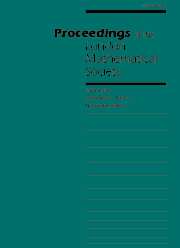Article contents
NORMALIZERS OF OPERATOR ALGEBRAS AND REFLEXIVITY
Published online by Cambridge University Press: 06 March 2003
Abstract
The set of normalizers between von Neumann (or, more generally, reflexive) algebras $\mathcal{A}$ and $\mathcal{B}$ (that is, the set of all operators $T$ such that $T \mathcal{A} T^{\ast} \subseteq \mathcal{B}$ and $T^{\ast} \mathcal{B} T \subseteq \mathcal{A}$) possesses ‘local linear structure’: it is a union of reflexive linear spaces. These spaces belong to the interesting class of normalizing linear spaces, namely, those linear spaces $\mathcal{U}$ of operators satisfying $\mathcal{UU}^{\ast} \mathcal{U} \subseteq \mathcal{U}$ (also known as ternary rings of operators). Such a space is reflexive whenever it is ultraweakly closed, and then it is of the form $\mathcal{U} = \{T : TL = \phi (L) T$ for all $L \in \mathcal{L}\}$ where $\mathcal{L}$ is a set of projections and $\phi$ a certain map defined on $\mathcal{L}$. A normalizing space consists of normalizers between appropriate von Neumann algebras $\mathcal{A}$ and $\mathcal{B}$. Necessary and sufficient conditions are found for a normalizing space to consist of normalizers between two reflexive algebras. Normalizing spaces which are bimodules over maximal abelian self-adjoint algebras consist of operators ‘supported’ on sets of the form $[f = g]$ where $f$ and $g$ are appropriate Borel functions. They also satisfy spectral synthesis in the sense of Arveson.
2000 Mathematical Subject Classification: 47L05 (primary), 47L35, 46L10 (secondary).
- Type
- Research Article
- Information
- Copyright
- 2003 London Mathematical Society
- 3
- Cited by


